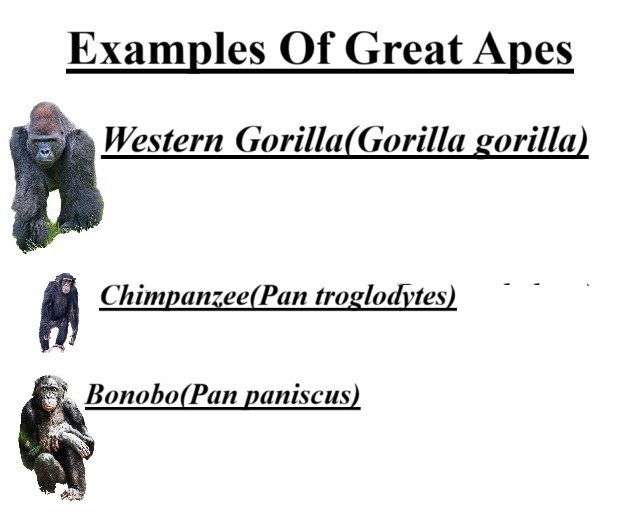
The animal kingdom is brimming with remarkable creatures, but few captivate us as profoundly as great apes. These extraordinary primates, known for their intelligence, social complexity, and deep emotional connections, are humans’ closest relatives in the natural world. Among the fascinating species that make up the great apes are The Chimpanzee(Pan troglodytes), Bonobo(Pan paniscus), gorillas, and orangutans. Great apes share almost 98-99% of our DNA.
Who Are The Great Apes?
The great apes belong to the mammalian family Hominidae, which excludes monkey species and includes humans. There are four main genera of great apes:
Chimpanzees (Pan troglodytes): Distributed across much of Africa, Chimpanzees are incredibly social, living in large communities with intricate social hierarchies. They are known for their tool-making abilities, hunting skills, and emotional expressions.
Bonobos (Pan paniscus): Often called “Pygmy Chimpanzees,” Bonobos are slightly smaller than their Chimpanzee cousins and are native to the Democratic Republic Of Congo. They are celebrated for their matriarchal societies and peaceful behaviors, often solving conflicts through social bonding and cooperation.
Gorillas (Gorilla gorilla and Gorilla beringei): These gentle giants are the largest of the great apes, known for their strong familial bonds and dominance by silverback males. Gorillas inhabit the forests of central Africa and are divided into two species: the Western Gorilla(Gorilla gorilla)and the Eastern Gorilla(Gorilla beringei)which includes the endangered Mountain Gorilla(Gorilla beringei beringei).
Orangutans (Pongo pygmaeus, Pongo abelii, and Pongo tapanuliensis): Native to the islands of Borneo and Sumatra, orangutans are arboreal (tree-dwelling) apes distinguished by their reddish-brown fur and solitary nature. They are highly intelligent, often using tools to gather food or solve problems. The three species of orangutans are: The Bornean Orangutan(Pongo pygmaeus), Sumatran Orangutan(Pongo abelii), and the Tapanuli Orangutan(Pongo tapanuliensis).
Humans (Homo sapiens) are also technically part of the great apes, but we are distinguished from our primate relatives by our advanced tool use, language, and organized religions. However, the similarities between humans and other great apes continue to astound researchers and blur the lines of distinction.
Behavior And Intelligence Of Great Apes
One of the most fascinating aspects of great apes is their cognitive ability. All great apes display problem-solving skills, advanced memory, the ability to use tools, and even self-awareness. For example, apes can recognize themselves in mirrors.
Great apes exhibit complex social structures. Chimpanzees and Bonobos form communities with interdependent relationships, while gorillas live in family troops led by a dominant male. The communication systems of great apes include vocalizations, gestures, facial expressions, and body language, all of which help them convey emotions or negotiate conflicts.
Tool use is another hallmark of great apes’ intelligence. Chimpanzees are known to fashion sticks for fishing termites, break nuts with stones, and use leaves as sponges to access water. Similarly, orangutans have been observed crafting tools to extract seeds or open fruit.
Apes are also emotionally sophisticated creatures. They demonstrate empathy, mourn for their dead, experience joy, and even engage in tickling or play. Researchers have observed touching scenes of gorilla mothers mourning their deceased infants or apes tending to injured companions.
The Conservation Crisis
Despite their incredible intelligence and emotional depth, great apes are in grave danger. All species of great apes are either endangered or critically endangered due to habitat destruction, illegal wildlife trade, and poaching. Their habitats in rainforests and lowlands are being decimated by deforestation caused by logging, mining, and the expansion of agriculture.
For example, the orangutan population has drastically declined in the last few decades, primarily due to the destruction of tropical forests for palm oil plantations. Similarly, gorillas in central Africa face significant threats from poachers, war, and the illegal bushmeat trade.
Conservation efforts for great apes are challenging but not impossible. Organizations and governments worldwide are working tirelessly to protect their habitats, enforce anti-poaching laws, and raise awareness about the plight of these amazing primates. Sanctuaries and rehabilitation centers also play a critical role in rescuing and rehabilitating apes that have been orphaned or displaced.
The Importance Of Protecting Great Apes
Great apes are more than just fascinating creatures—they are a vital part of Earth’s ecosystems. As seed dispersers, they play an important role in maintaining the health and diversity of the forests they inhabit. Protecting great apes, therefore, has a ripple effect on preserving global biodiversity.
Moreover, studying great apes can teach us invaluable lessons. By understanding their behaviors and intelligence, we learn more about ourselves, including our social behavior and emotional capacities. The survival of great apes is not just a matter of conservation; it’s a matter of preserving a part of our own humanity.
Conclusion
The great apes—Chimpanzees, Bonobos, gorillas, orangutans, and yes, humans—are a testament to the brilliance and complexity of life on Earth. Their intelligence, emotional depth, and social habits inspire awe and curiosity, but their existence also reminds us of our responsibility to protect the planet we share. As deforestation and human encroachment continue to threaten their survival, it is imperative that we take action to save these incredible species. For in the eyes of a great ape, we do not only see another animal—we see a reflection of ourselves.
